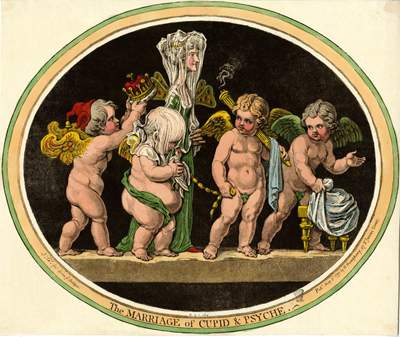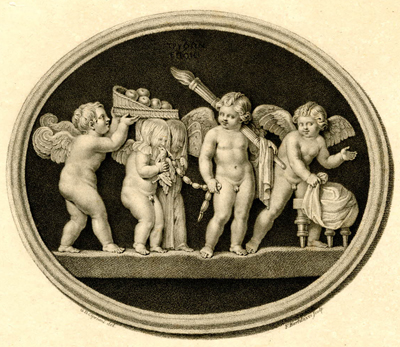The Marriage of Cupid and Psyche
Published a mere two days after the event, Gillray's print, The Marriage of Cupid and Psyche satirizes the long-expected marriage of the Earl of Derby with the actress, Elizabeth Farren. It does so with a brilliant visual parody of the famous cameo of Cupid and Psyche created by Tryphon in 50–25 B.C. But Gillray's "source" was unlikely to have been the gem itself, but rather the print/book illustration made by Cipriani and Bartolozzi and published in the first volume of Marlborough Gems in 1791.

© Trustees of the British Museum

Plate 50: Marriage of Cupid and Psyche [1791]
© Trustees of the British Museum
The disposition of the five figures against a black background within a horizontal oval is much the same in both versions, and the forms and attitudes of the three putti are beautifully mimicked. But there are also obvious differences. The putto holding up a basket of apples in the original is replaced with one wearing a bonnet rouge/fools cap and offering the Earl's coronet to the toweringly tall, thin, and prim figure of Miss Farren. Cupid has likewise been transformed from the cherubic putto of the original into the old and paunchy Earl of Derby. And the flame of Hymen's torch held by the central putto has gone out in Gillray's version.
But of course Gillray's treatment stems from the recognition that the story of the Earl and Miss Farren can readily be seen as a parody of the Cupid and Psyche tale itself. Appearing early on as part of Ovid's Metamorphoses, the story of Cupid and Psyche is on one level about the transformation that occured as a result of the god, Cupid, falling in love with the mortal, Psyche. After overcoming many trials and obstacles, Psyche was rewarded by being elevated to the status of a god. As a symbol of that transformation, Psyche's wings in both the original version and, even more prominently, in Gillray's version are not birds' wings, but the wings of a beautiful butterfly transformed from a lowly caterpillar.
The principal obstacle to a happy ending in Miss Farren's case was the continued existence of the first Lady Derby. In 1779, after five years of marriage, Elizabeth Hamilton, the Countess of Derby, had run off with the notorious womanizer, the Duke of Dorset, abandoning her three children in the process. In such a flagrant case of adultery, she fully expected to be granted a divorce from Derby which would then allow her to marry Dorset. The Earl, however, refused to cooperate, beginning an 18 year standoff in which the Countess of Derby was kept from their children and neither was able to marry.
While all this was happening, Elizabeth Farren was busy making a name for herself on the stage in a variety of comic and tragic parts, including Miss Hardcastle in She Stoops to Conquer and Hermione in The Winter's Tale. And there is no doubt that the Earl of Derby had begun to notice. Already by 1781, Derby and Miss Farren were linked in the press and in caricatures like Bunbury's Derby Diligence which shows the Earl on one of his much-prized horses following the carriage of Miss Farren. It would not have been exceptional for Miss Farren to become the Earl's mistress. But by most accounts, the relationship remained year after year resolutely platonic. The Bunbury print, for instance, contains the following caption:
When I followd a lass that was froward & shy
Oh I stuck to her stuff but she would not comply.
And in another print called The Platonic Lovers (1784) Derby sits in a theater box with Miss Farren (accompanied by her ever present mother as chaperone). Miss Farren holds a fan with an image of the virgin goddess of Diana, and wears a girdle or Cestus signifying chastity.
Gillray, however, seems to have taken a thoroughly jaundiced view of the relationship. In his earlier A Peep at Christies, or Tally-Ho, & his Nimeney-Pimmeney Taking the Morning Lounge (1796), he implicitly and unfairly compared Miss Farren to the courtesan Phryne when she tempted the chaste philosopher, Xenocrates. In the more recent Contemplations upon a Coronet (1797), Gillray implied that the actress was a gold-digger, focused only the journey from rags to riches, from "Strolling Lane to Derbyshire Peak." Here in this print, he portrays a mismatch in size and class in which the noble Earl is foolishly misled by his republican principles to bestow an earl's coronet upon a commoner in a marriage lacking the true flame of desire.
Gillray seems to have been wrong on almost all counts. When the first Lady Derby finally died on March 14th, 1797, the Earl displayed no lack of desire to consummate the relationship with his long-suffering partner. The marriage took place a mere six weeks later. And though beginning late (he was 45 and she was 38), the couple proceeded to have three children of their own.
Sources and Reading
- Commentary from the British Museum on The Marriage of Cupid and Psyche.
- Draper Hill, Fashionable Contrasts, 1966, #75
- "Elizabeth Farren," Wikipedia
- Memoirs of the Present Countess of Derby, late Miss Farren, by Petronius Arbiter,
- The Testimony of Truth to Exalted Merit; Or, a Biographical Sketch of the Right Honourable the Countess of Derby
- "Edward Smith-Stanley, 12th Earl of Derby," Wikipedia
- "Cupid and Psyche," Wikipedia
- Thomas Wright and R.H. Evans, Historical and Descriptive Account of the Caricatures of James Gillray #432.
- Thomas Wright and Joseph Grego, The Works of James Gillray, the Caricaturist; With the History of His Life and Times p. 229.
Comments & Corrections
NOTE: Comments and/or corrections are always appreciated. To make that easier, I have included a form below that you can use. I promise never to share any of the info provided without your express permission.